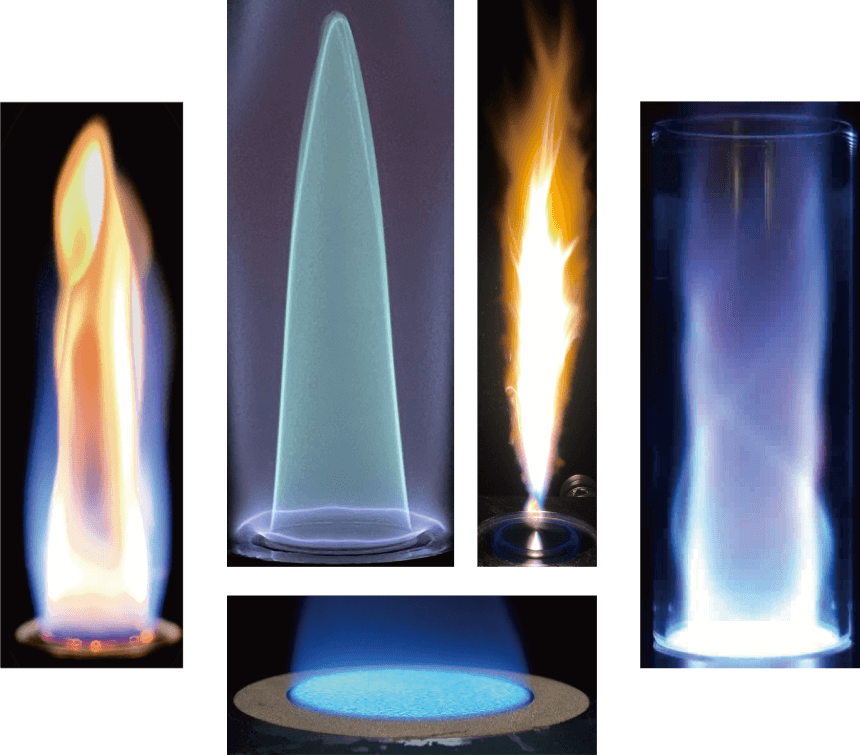Interview of Assistant Professor Tomoyuki HIRANO
Manipulating Flames to Fabricate Macro-scale Devices from Nano-scale Particles

| Program | JST Strategic Basic Research Programs (ACT-X) | Researchers selected in the FY | 2024 |
|---|
Using Flames to Design Functional Particulate Materials
My research focuses on the subset of chemical engineering known as particle technology. Perhaps you are not familiar with particles; they are used in many everyday applications like battery electrodes and smartphone coatings. Particle technology study has a long history in Japan, and is one of the essential foundation blocks of many engineering disciplines.
The small particles we deal with have different names according to size (e.g., “fine particle” and “powder”); my research is focused on fine particles, specifically those of inorganic materials, which range in size from nanometers to hundreds of micrometers. With their different sizes and shapes, particles have different surface areas in relation to their mass, which means that particles of the same material exhibit very different characteristics. In light of which, one aim of particle technology study is to design and synthesize functional particulate materials, right down to their size, shape, composition, and other properties. In my research, we use flame in the process of that synthesis.
One-step Device Fabrication
Take a battery, for example. This is made by layering catalytic particles on a substrate, so its fabrication involves multiple processes, including combining the raw materials, inducing reaction to make fine particles, separating and refining the particles, dispersing them in solvent, applying them to the substrate, and drying. Each of these processes requires specialized knowledge, and even then it’s not unusual for high-function particulate materials to lose expected performance during those processes.
My research project, Trans-Scale Design of Particle Layers using Flames, which has been selected for the Japan Science and Technology Agency’s (JST) ACT-X program, differs from those conventional multi-step methods by aiming to create a device that uses flame to build up particle layers in a single step.
Just as glass held over a candle flame turns black because soot (i.e., carbon particles) adhere to the surface, placing materials in flame and causing them to react generates floating particles, which can then be adhered to a substrate. Thus, it is possible to make electrodes in a single step—i.e., combusting the materials—thereby eliminating the need for those multiple processes of mixing materials and dispersing particles.
“Trans-scale design” refers to the design of materials that span the size range by enabling the creation of electrodes and other macro-scale devices from nanoparticles. Moreover, it is an integral part of the research area within the ACT-X program in which this project is included: Trans-Scale Approach Toward Materials Innovation.
Heating the flame to around 2,000 degrees Celsius and passing the material through it for just a very short time makes it possible to subject the synthetic material to a temperature difference that would normally be impossible. This results in changes to the material that can be harnessed.
However, not just any old flames will do—different materials and devices require different kinds of flame. I make my own burners and other devices to make sure I get the required flame, and these homemade burners’ ability to produce a variety of flames and control materials is one of the outstanding points of my research.

Some of the flame types generated by Asst. Prof. Hirano’s homemade burner.

For example, when layering catalyst particles on a substrate, dissolving catalysts such as platinum in a flammable solvent and igniting it first turns the material into a gas in the high-temperature field of the flame, whereafter it cools and condenses into nanoparticles that stick to the substrate. The volume and size of the platinum particles and the way they attach to the substrate can be regulated through precise control of parameters such as flame temperature, combustion gas composition, and material concentration.
Previously, my research mainly focused on preparing particles using flame. This ACT-X supported project is a progression of that, focusing on adhering fine particles to substrates, which requires stricter combustion control, and that is why I have begun by building my own burners and other equipment. My aim for the 2½-year ACT-X period is to achieve complete flame control so as to create useful batteries and electrolytic devices.
Focusing on Flame
Currently, my research focuses on electrode materials, but after rubbing shoulders with the many other researchers involved in the ACT-X program, I feel that flame-based synthesis has the potential for use with a wider variety of objects. For instance, if controlling combustion allows for free control of catalyst particle parameters, that ability could be harnessed to produce the catalysts used for organic synthesis in drug manufacture with more appropriate properties.
Moreover, while I have previously studied using flame to synthesize particles, I now intend to focus on the flame itself. Analyzing the status and inner workings of a flame in the process of particle synthesis is far from easy, and I look forward to using lasers to research flame diagnostic techniques with the aim of unlocking the secrets of flame and its control.

